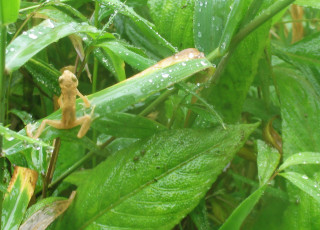William Newmark, Ph.D.
Vertebrate Zoology-Resident Research Associate
William Newmark is a research curator and conservation biologist in the Natural History Museum of Utah. He holds a B.A. in biology from the University of Colorado, a M.S. in wildland management from the University of Michigan, and a Ph.D. in ecology from the University of Michigan. His research is focused on patterns of extinction of vertebrate species, protected area and wildlife corridor design, and animal movement. His findings on patterns of extinction of large mammals in western North American and Tanzanian parks and birds on tropical forest fragments have highlighted the problems that nature reserves face in conserving biological diversity and have provided an important justification for a series of worldwide initiatives to link national parks and related reserves with wildlife corridors. He has been conducting field research for four decades in western North America and East Africa. He has written two books and more than 145 scientific papers and technical reports. He also serves as an international consultant in conservation biology to a number of bilateral and multilateral donor organizations including serving for 20 years as a senior technical consultant on biodiversity conservation to the World Bank.
Selected Publications
Books
Newmark, W.D. 2002. Conserving Biodiversity in East African Forests: A Study of the Eastern Arc Mountains. Ecological Studies. Springer-Verlag, New York.
Newmark, W.D. (ed.) 1991. The Conservation of Mount Kilimanjaro. IUCN, Gland.
Papers
Neate-Clegg, M.H.C., Tingley, M.W., Newmark, W.D. 2024. Afromontane understory birds increase in body size over four decades. Ecography. doi: 10.1111/ecog.07106.
Newmark, W.D., Halley, J.M, Beier, P, Cushman, S.A., McNeally, P.B., Soulé, M.E. 2023. Enhanced regional connectivity between western North American national parks will increase persistence of mammal species diversity. Scientific Reports. 13: 474 https://doi.org/10.1038/s41598-022-26428-z.
Neate-Clegg, M.H.C., Etterson, M.A., Tingley, M.W., Newmark, W.D. 2023. The combined effects of temperature and fragment area on the demographic rates of an Afrotropical bird community over 34 years. Biological Conservation 282: https://doi.org/10.1016/j.biocon.2023.110051.
Mtui, D.T., Ogutu, J.O, Okick, R.E., Newmark, W.D. 2022. Elevational distribution of montane Afrotropical butterflies is influenced by seasonality and habitat structure. PLOS One 17(7): e0270769. https://doi.org/10.1371/journal.pone.0270769.
Neate-Clegg, M.H.C., Stanley, T.R., Şekercioğlu, Ç.H., and Newmark, W.D. 2021. Temperature-associated decreases in demographic rates of Afrotropical bird species over 30 years. Global Change Biology 00:1–15. https://doi.org/10.1111/gcb.15567.
Neate-Clegg, M.H.C., Stuart, S.N., Mtui, D., Şekercioğlu, Ç.H., and Newmark, W.D. 2021. Afrotropical montane birds experience upslope shifts and range contractions along a fragmented elevational gradient in response to global warming. PLOS One https://doi.org/10.1371/ journal.pone.0248712.
Newmark, W.D., Mkongewa, V.J., Amundsen, D.L., and Welch, C. 2020. African sunbirds predominantly pollinate plants useful to humans. The Condor: Ornithological Applications 122:1-9.
Newmark, W.D. and Mkongewa, V.J. 2020. Nest predation of an African Paradise Flycatcher (Terpsiphone viridis) by an Olive Sunbird (Cyanomitra olivacea). The Wilson Journal of Ornithology 32:463–466.
Brodie, J.F. and Newmark, W.D. 2019. Heterogeneous matrix habitat drives species occurrences in complex, fragmented landscapes. The American Naturalist 193:748-754.
Newmark, W.D. and McNeally, P.B. 2018. Impact of habitat fragmentation on the spatial structure of the Eastern Arc forests in East Africa: implications for biodiversity conservation. Biodiversity and Conservation. 27: 1387-1402.
Werner, U, Banks-Leite C, De Coster, G., Habel, J.C., Matheve H., Newmark, W.D., Tobias, J.A. and Lens L. 2018. Environmentally and behaviourally mediated co-occurrence of functional traits in bird communities of tropical forest fragments. Oikos 127: 274-284.
Newmark, W.D., Jenkins C.N., Pimm S.L., McNeally P.B., and Halley, J.M. 2017. Targeted habitat restoration can reduce extinction rates in fragmented forests. Proceedings of the National Academy of Sciences USA 114: 9635-9640.
Newmark, W.D., and Stanley, T.R. 2016. The influence of food abundance, food dispersion, and habitat structure on territory selection and size of an Afrotropical insectivore. Ostrich 87: 199-207.
Halley, J.M., Monokrousos, N., Mazaris, A.D., Newmark, W.D., and Vokou, D. 2016. Dynamics of extinction debt across five taxonomic groups. Nature Communications 7:12283.
Morrison, T.A, Link, W.A, Newmark, W.D., Foley, C.A.H., and Bolger, D.T. 2016. Tarangire revisited: consequences of declining connectivity in a tropical ungulate population. Biological Conservation 197: 53-60.
Habel, J.C., Borghesio, L., Newmark, W.D., Day, J.J., Lens, L., Husemann, M., and Ulrich, W. 2015. Evolution along the Great Rift valley: phenotypic and genetic differentiation of East African White-eyes (Aves, Zosteropidae). Ecology and Evolution 5:4849-4862.
Newmark, W.D., Stanley, W.T., and Goodman, S.M. 2014. Ecological correlates of vulnerability to fragmentation among Afrotropical terrestrial small mammals in northeast Tanzania. Journal of Mammalogy 95: 269-275.
Mkongewa, V.J., Newmark, W.D., and Stanley, T.R. 2013. Breeding biology of an Afrotropical forest understory bird community in northeast Tanzania. The Wilson Journal of Ornithology 125: 260-267.
Korfanta, N., Newmark, W.D., and Kauffman, M.J. 2012. Long-term demographic consequences of habitat fragmentation to a tropical understory bird community. Ecology 93:2548–2559.
Newmark, W.D. and Rickart, E.A. 2012. High-use movement pathways and habitat selection by ungulates. Mammalian Biology 77: 293-298.
Newmark, W.D. and Stanley, T.R. 2011. Habitat fragmentation reduces nest survival in an Afrotropical bird community in a biodiversity hotspot. Proceedings of the National Academy of Sciences USA 108: 11488-11493.
Stanley, T.R. and Newmark, W.D. 2010. Estimating length of avian incubation and nestling stages for Afrotropical forest birds from interval-censored nest records. Auk 127: 79-85.
Newmark, W.D., Mkongewa, V.J. and Sobek, A.D. 2010. Ranging behavior and habitat selection of terrestrial insectivorous birds in northeast Tanzania: implications for corridor design in the Eastern Arc Mountains. Animal Conservation 13: 474-482.
Newmark, W.D. 2008. Isolation of African protected areas. Frontiers in Ecology and Environment 6: 321-328.
Bolger, D.T., Newmark, W.D., Morrison, T.A., and Doak, D.F. 2008. The need for integrative approaches to understand and conserve migratory ungulates. Ecology Letters. 11:63-77.
Newmark, W.D. and Rickart, E.A. 2007. Are natural history museums telling the right story? Bioscience 57: 390.
Hanson,T.R, Newmark, W.D., and Stanley, W.T. 2007. Forest fragmentation and predation on artificial nests in the Usambara Mountains, Tanzania. African Journal of Ecology 45:499-507.
Newmark, W.D. 2006. A 16-year study of forest disturbance and understory bird community structure and composition in Tanzania. Conservation Biology. 20:122-134.
Newmark, W.D. 2001. Tanzanian forest edge microclimatic gradients: dynamic patterns. Biotropica 33:2-11.
Newmark, W.D. and Hough, J.L. 2000. Conserving wildlife in Africa: integrated conservation and development projects and beyond. BioScience 50:585-592.
Newmark, W.D. 1998. Forest area, fragmentation, and loss in the Eastern Arc Mountains: implications for the conservation of biological diversity. Journal of East African Natural History 87:29-36.
Newmark, W.D. 1996. Insularization of Tanzanian parks and the local extinction of large mammals. Conservation Biology 10:1549-1556.
Newmark, W.D., Boshe, J.I., Sariko, H.I. and G.K. Makumbule. 1996. Effects of a highway on large mammals in Mikumi National Park, Tanzania. African Journal of Ecology 34:15-31.
Davidson, D.W., Newmark, W.D., Sites, J.W. Jr., Shiozawa, D.K., Harper, K.T., Rickart, E.A.,and R.B. Keiter. 1996. Selecting BLM wilderness areas to conserve Utah's biological diversity. Great Basin Naturalist 56:95-118.
Newmark, W.D. 1995. Extinction of mammal populations in western North American national parks. Conservation Biology 9:512-526.
Newmark, W.D., Manyanza, D.M., Gamassa, D.M., and H.I. Sariko. 1994. The conflict between wildlife and local people living adjacent to protected areas in Tanzania: human density as a predictor. Conservation Biology 8:249‑255.
Newmark, W.D., Leonard, N.L., Sariko, H.I., and D.M. Gamassa. 1993. Conservation attitudes of local people living adjacent to five protected areas in Tanzania. Biological Conservation 63:177‑183.
Newmark, W.D. 1993. The role and design of wildlife corridors with examples from Tanzania. Ambio 12:500‑504.
Newmark, W.D. 1987. A land‑bridge island perspective on mammalian extinctions in western North American parks. Nature 325:430‑432.
Newmark, W.D. 1986. Species‑area relationship and its determinants for terrestrial mammals in western North American national parks. Biological Journal of the Linnean Society 28:83‑98.
Newmark, W.D. 1985. Legal and biotic boundaries of western North American national parks: A problem of congruence. Biological Conservation 33:197‑208.

